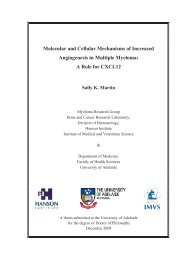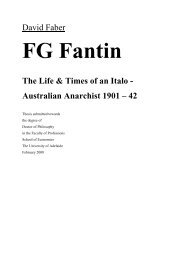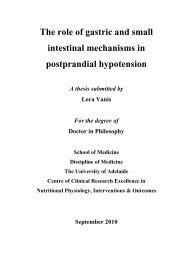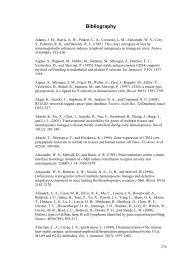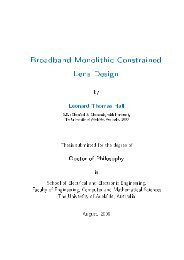HiCIRF: A highfidelity HF channel simulation - Digital Library
HiCIRF: A highfidelity HF channel simulation - Digital Library
HiCIRF: A highfidelity HF channel simulation - Digital Library
Create successful ePaper yourself
Turn your PDF publications into a flip-book with our unique Google optimized e-Paper software.
RS0L11<br />
NICKISCH ET AL.: HICIRF <strong>HF</strong> CHANNEL SIMULATION<br />
RS0L11<br />
propagation and modeling modules. Basic <strong>HF</strong> propagation<br />
mode structure is obtained by numerical ray tracing in a<br />
climatological ionosphere model. Ionospherically induced<br />
Doppler shifts are incorporated by evaluating temporal ray<br />
mode dependence in the evolving background ionosphere<br />
model. Signal scatter effects are computed using the theory<br />
of stochastic wave propagation in the environment predicted<br />
by WBMOD, a climatological model for naturally occurring<br />
small-scale ionization structure [Secan, 2004]. Doppler<br />
spreading of scattered fields is incorporated through the use<br />
of plasma drift models. These important <strong>HiCIRF</strong> elements<br />
are discussed in this section.<br />
2.1. Numerical Ray Tracing<br />
[8] We employ the Haselgrove ray tracing codes developed<br />
by Coleman [1993, 1997, 1998] in both two-dimensional<br />
(range and height) and three-dimensional magnetoionic<br />
versions. These codes are probably the fastest numerical<br />
Hamiltonian-based ionospheric ray tracing codes in the world,<br />
which makes them particularly desirable for the computationally<br />
intensive <strong>simulation</strong> application. The extremely fast<br />
2D code is used for components in <strong>HiCIRF</strong> that require less<br />
fidelity (clutter and noise calculations) and the 3D code is<br />
used for target signal injection. For one-way link geometries,<br />
we have developed a ray homing technique that finds all<br />
propagation modes connecting a given transmitter and receiver.<br />
For the two-way (radar) geometry, we have developed algorithms<br />
for finding all connecting return paths from each outbound<br />
hop for separated transmitter and receiver locations.<br />
2.2. Small-Scale Ionization Structure<br />
[9] The goal of <strong>HiCIRF</strong> is to provide a <strong>simulation</strong> of the<br />
<strong>HF</strong> <strong>channel</strong> that can be used to generate <strong>HF</strong> signal realizations.<br />
An important aspect of the <strong>HF</strong> <strong>channel</strong> is the effect of<br />
small-scale ionization structure that causes signal decorrelation<br />
in space, frequency, and time. We have developed<br />
modules for these stochastic random media propagation<br />
calculations. These modules are based on FORTRAN code<br />
that is callable by MATLAB using the MATLAB MEX<br />
utilities. The use of compiled FORTRAN MEX modules<br />
allows these numerically intensive calculations to be performed<br />
with computational speed that could not be attained<br />
in a normal MATLAB script.<br />
[10] The climatology of naturally occurring small-scale<br />
ionization structure is available in the software package<br />
WBMOD [Secan, 2004]. We have extracted from WBMOD<br />
the subset of subroutines that are required for <strong>HiCIRF</strong> and<br />
made a MATLAB MEX module of them. We have constructed<br />
a module that samples the WBMOD-predicted<br />
structure along rays for passage to our <strong>channel</strong> realization<br />
module (discussed below).<br />
2.3. Plasma Drift Model<br />
[11] We have incorporated the ionospheric plasma drift<br />
velocity model from WBMOD, which combines the Richmond-<br />
NCAR (mid-low latitude) and Heelis-UTD (high latitude)<br />
plasma convection models [Richmond et al., 1980; Hairston<br />
and Heelis, 1990]. These models capture the nighttime<br />
equatorial eastward drift of 100–150 m/s and the km/s-scale<br />
plasma drifts in the polar region. The equatorial drift<br />
combined with the strong nighttime equatorial small-scale<br />
ionization structure is responsible for the bulk of Spread<br />
Doppler Clutter (SDC) observed by OTHRs looking toward<br />
the equator.<br />
3. Theoretical Considerations<br />
[12] The output of <strong>HiCIRF</strong> is the Channel Impulse<br />
Response Function that applies the effect of the ionospheric<br />
<strong>channel</strong> on propagating waveforms through convolution.<br />
Realizations of the impulse response function can be generated<br />
using the Generalized Power Spectral Density<br />
(GPSD) function of the propagation <strong>channel</strong>, and in this<br />
section we describe this relationship.<br />
[13] There is a specialized, but rich literature on the<br />
development of radiowave scattering theory in structured<br />
ionization. References to this literature can be found in the<br />
works by Nickisch [1992], Dana and Wittwer [1991], and<br />
Gherm et al. [2005]. The work of Gherm et al. [2005]<br />
is specifically directed toward the <strong>HF</strong> applications targeted<br />
here, but is restricted to the weak-scatter regime for the<br />
scattering effects of small-scale ionization structure through<br />
their application of an extended Rytov approximation [Rytov<br />
et al., 1978]. The theory we apply in <strong>HiCIRF</strong>, that of<br />
Nickisch [1992], invokes certain strong-scattering assumptions<br />
which are valid for the description of the equatorial and<br />
polar/auroral Spread Doppler Clutter (SDC) that affects <strong>HF</strong><br />
OTH radar. In order to blend this strong-scattering theory<br />
with the weak-scatter regime appropriate, for example, to<br />
OTH radar path segments in midlatitudes, we take a Rician<br />
approach that we will also describe below. Also, as discussed<br />
by Nickisch [1992], applying phase screen/diffraction<br />
method (PDM) as we do in <strong>HiCIRF</strong>, using the spherical<br />
wave version of the parabolic wave equation, neglects<br />
certain effects associated with the refraction in the background<br />
ionosphere model. We account for variation along<br />
the propagation path of important factors that have to do<br />
with the angle between the propagation direction and the<br />
geomagnetic field (along which small-scale ionospheric<br />
structures tend to elongate), but otherwise ignore mean path<br />
curvature for the stochastic calculations. According to the<br />
<strong>channel</strong> probe examples given by Nickisch [1992] and other<br />
OTH radar validation testing we have performed [Knepp et al.,<br />
2012], this approach seems adequate as long as the propagation<br />
path remains reasonably oblique (avoiding very steep<br />
refraction). However, potential effects associated with the <strong>HF</strong><br />
sky wave reflection caustic and losses due to scattering into<br />
higher angles than the current ionosphere can refract back<br />
down are certainly being ignored in this approach.<br />
[14] The PDM theory of Nickisch [1992] provides an<br />
analytical expression of the mutual coherence function for<br />
spaced frequency, position, and time in terms of sums and<br />
products over a number of phase screens defined along the<br />
propagation path. PDM also provides analytical expressions<br />
for the stochastic signal structure parameters by which the<br />
Dana and Wittwer [1991] General Model GPSD is parameterized.<br />
The stochastic signal structure parameters include<br />
l x and l y , the signal correlation lengths in the shortest (x) and<br />
longest (y) correlation directions orthogonal to the ray<br />
direction (these directions are defined by the ray geometry<br />
relative to the geomagnetic field and, hence, vary along the<br />
refracting <strong>HF</strong> raypath). Sometimes the designation l o is<br />
2of10




